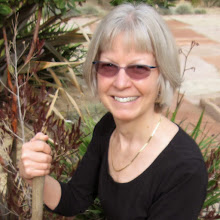
This Mountain Blue Gum (Eucalyptus deanei) is about 75 feet tall, over 90 years in age and long ago formed two main trunks. It is one of four trees in the City, which have been designated landmarks of historic significance. Other listed trees include a Deodar Cedar (Cedrus deodara) and a Yate Gum (Eucalyptus cornuta.) The two Eucalypts are native to Central New South Wales and Coastal (southwestern) West Australia, respectively. They both need quite a bit of moisture to thrive. Deodar Cedar is native to the western part of the Himalayas. It is the national tree of Pakistan. A very adaptable species, it has been planted in many climate zones from the desert Southwest to the Pacific Northwest. These three trees are all massive for their sites. Their unfortunate urban existence reminds one of animals in a zoo. However, just as many of our zoo friends, they have much to teach us about adaptation and survival. Beneath their crowded canopies a lovely, shaded spot eludes tranquil respite. Yet, one can dream…
Just one California native is listed with “landmark” status in Santa Monica, a “California” (or Coast) Live Oak (Quercus agrifolia.) We did not stop to see it, as it is not visible from the street.
Residents and City urban forestry folks will decide whether other Santa Monica trees should achieve such distinction and protection. Street-side tree planning will look at how to sustain the urban tree canopy for the next fifty years.
Various species of Ficus (Fig), with large surface feeder roots play havoc with sidewalks, curbs and gutters. La Mesa Drive, north of San Vicente, is lined with Moreton Bay Fig (Ficus macrophylla) – see photo below. Wider than typical parking strips allow some room for surface roots, showing this tree species’ ability to adapt to its adoptive home. Yet, in its native habitat, it grows in coastal mangroves, its toes luxuriating in the warm, salty mud.

Many difficult conflicts arise between urbanization and urban forestation. Some think of urbanization as progress. How will progress be defined? Will growing cities make room for trees? Or, will trees be forced to adapt to increasing urbanization. Revenues in the wealthy seaside community of Santa Monica support a tree maintenance budget, we were told, in the neighborhood of one million dollars annually “and needs to stay there.” Yet, so many lovely street trees only hang onto just the edge of existence, restricted to perhaps one quarter to half the size they want to be. Microscopic organisms are at work to ensure only the fittest trees survive. Thoughtful discussions led to the creation of an Urban Forest Task Force. Knowledgeable voices are to be heard. Appropriate planning is tasked. Seeds ready to germinate?...

Later in the day, I picked up a friend and drove to Glendale for late lunch at Foxy’s. That’s definitely a place I’ll put on my special list. Would have loved to photograph the San Gabriels in their snow-capped splendor on the drive out, but hands dutifully on the steering wheel! You’ll just have to visit Barbara Eisenstein’s blog Wildsuburbia for the view!




3 comments:
It's a shame we don't invest more in street trees. A friend told me in truly urban areas they have a survival rate of like 3%. I lived in Mendoza, Argentina for a while and there they have an elaborate irrigation canal system through the entire area that waters trees. Almost all streets are lined with beautiful, tall, old trees. And since it's a semi-arid, desert climate it also helps with cooling down the town and allowing for pleasant walks even during the heat of the day.
Perhaps we need to bring the idea of tree-lined boulevards here to the US to give trees some space.
"bradzio", couldn't agree more! Want to help with a local project on one of our major throughways, Ventura Boulevard, Woodland Hills. (The HOT spot of Los Angeles.) We can get (theoretically free) trees from the City. Challenged to see how to influence what species they give us, and then, how to improve survival success rate on less than a shoestring budget!
fabulous trees!
Post a Comment